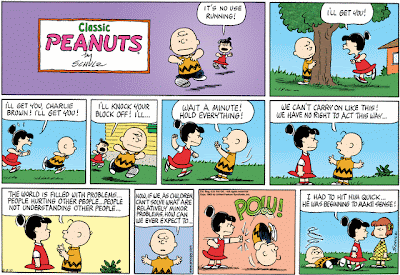
In reading Yaszek's article about the Americanization and the Comic Strip during the Progressive Era, I couldn't help but to think of the Sunday daily series, the Classic Peanut cartoons by Charles M. Shutlz. His prolific output of cartoons featuring the characters, Charlie Brown, Lucy and Snoopy, led him to touch upon many aspects of American life as well as some political debates. Its social commentary is similar to the ones described in the series, Yellow Kid. It does not shy away from violence, as Lucy socks one to Charlie Brown.... This action has a series of interpretations, perhaps in part to Lucy being somewhat ignorant and stubborn, or perhaps it is Charlie Brown who is incorrectly verbalizing? Because of the reverberating presence of the Peanut comic strips, it has the same dialogic relationship with the middle class america as it did during the Progressive Era?
The use of speech bubbles and dialogue reinforces the actions of these two “classic” american children. Charlie Brown, an innocent boy sort of wards off the Lucy who is frantically chasing after him, for unknown reasons, perhaps one that was portrayed in an earlier series. Charlie, tries to settle the dispute by stating a “worldly opinion” stating, “ wait a minute hold everything!” “ we have no right to act this way, the world is filled with problems... people hurting other people... people not understanding other people..” “now if we, as children can't solve what are relatively minor problems how can we ever expect to...” “pow” and Lucy hits him. I think that the satirical and irony of this situation that Charlie Brown has gotten into is the reverse character gender roles. It would have a different connotation if Charlie Brown started to hit Lucy, but Lucy, hitting Charlie Brown allows it to become humorous. Much like the Yellow Kid series, where laughter breeds contemplation. Who are we laughing at per say? The minimal stylization also allows the comic to become more accessible, it has many layers to the story other than the ones being stated in the speech bubbles. In terms of promotion for Americanization, I think this comic is more of a comment on typical American behavior and life rather than on the promotion of immigrants to adopt “american” like beliefs. “While popular comic strips were produced by members of the middle class, they were marketed toward a much wider audience. The comic strip originally appeared in the sensation papers to boost circulation, especially amongst the lower-middle and working classes.” The indication that this cartoon might be a form of Progressivist mentality is that it has a middle class typical attitude to the piece, but in order to gain availability to a broader public, it appeared in magazines, newspapers, etc. a publication read by the masses, in opposition to the artwork of the elites.

No comments:
Post a Comment